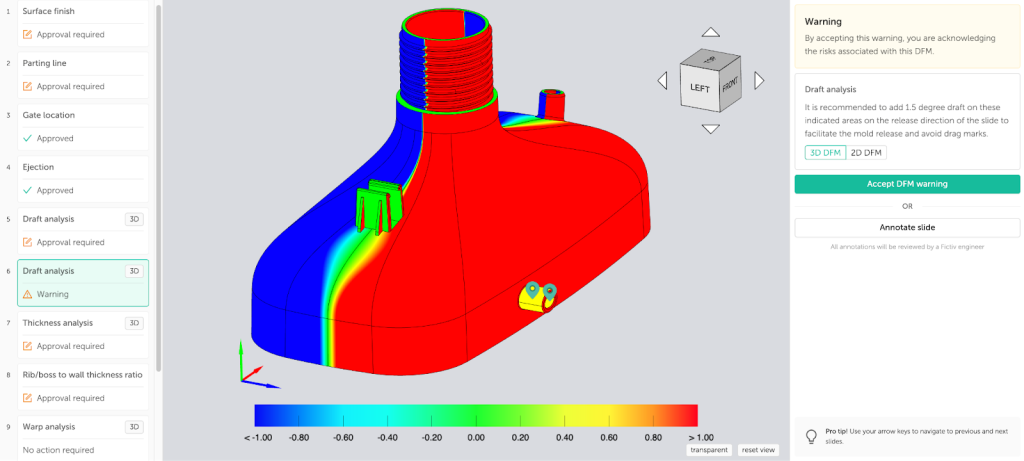Adding 3D Visualization to its Injection Molding DFM System is the latest example of the company’s innovation and expansion in the market.
Fictiv, a San Francisco-based manufacturing bureau, has added 3D visualization to its injection molding Design for Manufacturability (DFM) system. Fictiv says it’s Digital Manufacturing Ecosystem delivers high-quality parts at unprecedented speed. According to Fictiv, the enhanced software enables complete automation of injection molding workflows, allowing clients to speed up new product design and reduce manufacturing risks and delays. The recently improved system integrates digital manufacturability issue tracking, part version control, and communication tools. 3D visualization also significantly speeds up how quickly engineering teams can request, assess, and react to injection molding DFM input and approve parts for production.
“Our goal at Fictiv is to simplify sourcing for complex injection molding tools and parts our customers need by enabling them to order quickly and easily, with minimal redesign and risk, and with expert guidance every step of the way,” said Chris Lippi, chief product officer at Fictiv. “As a technology-forward manufacturing solution, Fictiv is able to provide a digital experience that is radically more efficient and streamlined than the industry’s antiquated approach of sharing marked-up drawings over email.”
Dilan Silva, a mechanical engineer at Thermo Fisher Scientific, has over twenty-five years of experience working with vendors for custom jobs, said, “Fictiv is by far the easiest to quote, most economical, and Fictiv always delivers my parts on time. Fictiv offers many domestic and international manufacturing options to fit my budget and schedule. The quality of the parts received is exceptional, and their customer service is one of the best I’ve experienced. Fictiv is consistently evolving manufacturing technologies while driving costs and improving operational efficiency.”

What is a Design for Manufacturing (DFM) System?
Design for Manufacturing (DFM) is the process of creating products, parts, or components with how they are to be produced in mind, this should result in goods that are simple to manufacture at a reduced cost. This is accomplished by streamlining, improving, and perfecting the product design. Sometimes DFM and the abbreviation DFMA (Design for Manufacturing and Assembly) are used interchangeably.
DFM should ideally take place early in the design process, well before tooling has started. All parties involved in the project, including engineers, designers, contract manufacturers, mold builders, and material suppliers, must be included. The intent of this “cross-functional” DFM is to examine the design from all angles, including the component, sub-system, system, and holistic levels, in order to verify that it is cost-effective and optimal.

Workflow optimization and software-assisted or generative design
Workflow optimization uses strategies and tactics to increase the efficiency of administrative, industrial, and other processes within an organization. Efficient workflow optimization will decrease expenses, the likelihood of errors, and the amount of time needed to complete tasks. Businesses’ competitiveness and long-term performance depend on workflow optimization efficiency. A firm can focus more of its resources on boosting customer happiness and improving its products and services by reducing the amount of time spent fixing mistakes or carrying out unimportant tasks.
For example, a new production planning and manufacturing scheduling solution was released by New York-based 3D printing software developers LINK3D for their additive manufacturing workflow software. The Production Planning System (PPS), supported by sophisticated Build Simulation and machine connectivity, is made to help customers manage capacity, track and trace yield, and maximize machine use.
Previously, Gravity Pull Systems, a software developer for additive manufacturing, had developed a comprehensive workflow optimization system for industrial 3D printing. The AI-based software, Synoptik, is intended for service bureaus and manufacturing firms serving industries including aerospace, healthcare, and automotive. Synoptik aims to address every gap in the market by offering optimization procedures for each stage of the 3D printing workflow, from pre-processing through post-processing and quality inspection.
Software-assisted design can also be considered as a way to speed up product design. For example, one method is generative design – a software-assisted iterative design approach. Engineering software developer nTopology has been actively working on a plethora of new advancements. The company’s software, which first went on sale in 2019, combines simulation and generative design to let customers construct complicated parts that are suited for additive manufacturing methods. As a result, the platform transcends the geometric constraints of current conventional engineering design tools and embodies the concepts of Design for Additive Manufacturing (DfAM).
Nominations for the 3D Printing Industry Awards 2022 have now commenced. Who do you think should make it to the shortlists for this year’s show? Nominate now, the form closes at the end of the month.
To stay up to date with the latest 3D printing news, don’t forget to subscribe to the 3D Printing Industry newsletter or follow us on Twitter, or liking our page on Facebook.
While you’re here, why not subscribe to our Youtube channel? featuring discussion, debriefs, video shorts, and webinar replays.
Are you looking for a job in the additive manufacturing industry? Visit 3D Printing Jobs for a selection of roles in the industry.
Featured image shows the Fictiv DFM system with 3D visualization. Image via Fictiv.



